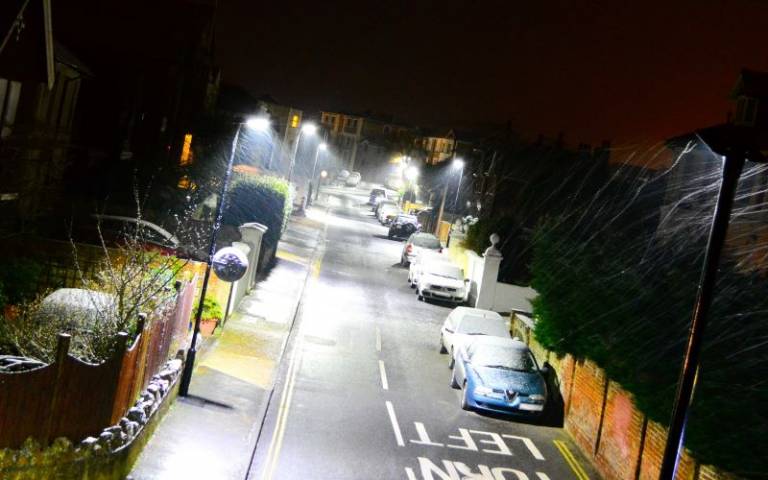Street lighting may enable rather than hinder street crime
30 March 2022
Fewer cars are broken into at night on roads with part-night lighting (PNL), where street lights are switched off between midnight and 5am, finds researchers from UCL and the London School of Hygiene & Tropical Medicine.

The rate of thefts from cars at night was halved on roads with PNL, compared to the same roads before PNL was introduced. Car break-ins decreased from an average of 12 per street, per month, to six per street, per month.
This coincided with a 1.5x increase in vehicle crime on nearby roads where the lighting remained on all night, suggesting some criminals are deciding to move to better-lit streets nearby.
For the paper, published in the Journal of Quantitative Criminology, the team, led by UCL and the LSHTM as part of the LANTERNS project, examined detailed police recorded crime data from Thames Valley Police and data on changes to street lighting in Oxfordshire and west Berkshire from April 2004 to September 2013.
LANTERNS is a national collaboration between LSHTM and UCL Security & Crime Science that aims to quantify any effects of changes in street lighting on road traffic crashes and crimes.
They also found that fewer crimes were displaced to nearby roads, meaning there was an overall net reduction in crime. Thefts of vehicles also reduced in number, but this was not statistically significant.
Lead author Professor Shane Johnson (Director, Dawes Centre for Future Crime – Dept for Security & Crime Science) said: “Research studies such as this can help us to better understand crime and security issues. The study findings suggest that energy saving street lighting adaptations have not increased crime in the streets studied. This is very encouraging, but it is important to note that it does not mean that this will be the case under all conditions, and so changes to lighting should be managed carefully.”
Dr Phil Edwards (LANTERNS project lead and LSHTM) said: “The reason we did this research is because many local authorities in the UK have introduced part-night lighting on quiet, urban residential roads and rural roads, which have very little use after midnight, to save energy costs and reduce carbon emissions. However, safety concerns about this policy have been raised.
“Our previous research showed that switching off street lights at night does not increase crime. This new study suggests switching off street lights between midnight and 6am may actually reduce some types of crime.”
The team evaluated the impact on crime from changes to lighting at street level. In contrast to previous studies, the changes to street lighting involved reducing rather than increasing lighting provision. Three different types of lighting changes, PNL, dimming and white light (replacing yellow lamps with LEDs) were examined for five crime categories – residential burglary, robbery, vehicle crime and violence.
For roads with dimmed lighting there was also evidence of a reduction in night-time vehicle crime, relative to daytime crime, although the effect was less robust than for PNL. There was no evidence that white lighting was significantly associated with changes in any type of night-time crime examined by the researchers.
Dr Edwards continued: “We didn’t set out to find the reasons for the observed changes, but it is possible that when lighting is switched off after midnight, offenders consider that the costs of committing a crime, such as using a torch, would likely raise suspicion among residents and risk being witnessed, outweigh the benefits.
“When lighting is switched off after midnight the streets are likely to be in near darkness, which means that any would-be offenders may find it challenging to see if there are any valuable goods left unsecured in vehicles, so offenders may choose to move elsewhere to fulfil their intentions.”
The authors acknowledge limitations of the study, including that the findings reported are for only one of the 43 UK police force areas, meaning the findings might not be generalisable to the national level. For some crime reports the exact time of an offense was unknown, so some vehicle crimes may have occurred either before lights were switched off, of after they were switched on again.
The LANTERNS project was commissioned by the National Institute for Health Research (NIHR) to assess the impact of street lighting reductions on two important public health outcomes, road traffic injuries and crime.
Links
- Research paper Absence of street lighting may prevent vehicle crime, but spatial and temporal displacement remains a concern in Journal of Quantitative Criminology
- Professor Shane Johnson 's academic profile
- UCL Security & Crime Science
- UCL Engineering
- London School of Hygiene & Tropical Medicine (LSHTM)
Image
- Credit: Inner_Vision on iStock
Source
Media contact
Kate Corry
Tel: +44 (0)20 3108 6995
Email: k.corry [at] ucl.ac.uk
 Close
Close

